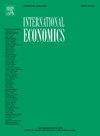How much debt is too much? Debt-growth dynamics in commodity-dependent and non-commodity-dependent developing economies
引用次数: 0
Abstract
This paper examines the debt-growth dynamics of commodity-exporting and non-commodity-exporting developing countries, examining whether public debt thresholds differ between these groups. We applied the dynamic panel data threshold effects model with endogenous regressors including both endogenous and exogenous instruments proposed by Kremer et al. (2013) and expanded by Seo and Shin (2016) and Seo et al. (2019). Using panel data for 46 countries from 1981 to 2019, the analysis identifies distinct debt thresholds for the two groups, revealing significant negative effects of debt on growth beyond 62.14% of GDP for commodity exporters over the period 1981–2000, and beyond 53.83% during 2001–2019. For non-exporters, a debt threshold has emerged only over recent decades and is identified at 67.96% of GDP, with low-to-moderate debt levels positively associated with growth. The results highlight the role of institutions, human and physical capital investment, and trade openness in mitigating the growth drag effects of debt, particularly concerning commodity exporters. These findings deepen our understanding of debt sustainability and growth in developing economies, emphasizing the unique vulnerabilities of resource-dependent countries.
多少债务算太多?依赖商品和不依赖商品的发展中经济体的债务增长动态
本文考察了商品出口和非商品出口发展中国家的债务增长动态,考察了这些群体之间的公共债务阈值是否存在差异。我们采用了由Kremer等人(2013)提出的动态面板数据阈值效应模型,该模型具有内生回归因子,包括内生和外生工具,并由Seo和Shin(2016)以及Seo等人(2019)扩展。利用1981年至2019年46个国家的面板数据,该分析确定了两组不同的债务阈值,揭示了1981 - 2000年期间债务对大宗商品出口国GDP增长的显著负面影响,超过62.14%,2001-2019年超过53.83%。对于非出口商而言,债务门槛是近几十年来才出现的,目前已确定为GDP的67.96%,低至中等的债务水平与经济增长呈正相关。研究结果强调了制度、人力和实物资本投资以及贸易开放在减轻债务对增长的拖累效应方面的作用,特别是对大宗商品出口国而言。这些发现加深了我们对发展中经济体债务可持续性和增长的理解,强调了资源依赖型国家独特的脆弱性。
本文章由计算机程序翻译,如有差异,请以英文原文为准。
求助全文
约1分钟内获得全文
求助全文
来源期刊

International Economics
Economics, Econometrics and Finance-Economics, Econometrics and Finance (all)
CiteScore
6.30
自引率
0.00%
发文量
74
审稿时长
71 days
 求助内容:
求助内容: 应助结果提醒方式:
应助结果提醒方式:


